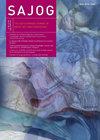难产:膀胱结石可能是原因
IF 0.4
Q4 OBSTETRICS & GYNECOLOGY
引用次数: 0
摘要
难产是妇产科常见的临床问题,头骨盆比例失调是最常见的原因。在此,我们报告一例罕见的由大膀胱结石引起的难产。该病人是一家地区医院因分娩进展迟缓而转诊来的病例。诊断大膀胱结石引起分娩梗阻是做阴道检查。阴道检查,可见大结石,直径约7厘米。触诊阴道前壁后方6cm处,阻止胎儿头部下降。施行紧急剖宫产术,同时行膀胱切开术取出膀胱结石。术后顺利。本文章由计算机程序翻译,如有差异,请以英文原文为准。
Labour dystocia: Vesical calculus can be the cause
Obstructed labour is a well-known clinical entity in maternity units, cephalopelvic disproportion being the most common cause. Here, we report a rare case of obstructed labour resulting from a large vesical calculus. The patient was a referred case from a district hospital for delayed progress of labour. The diagnosis of large vesical calculus causing labour obstruction was made by doing a vaginal examination. On vaginal examination, a large calculus of apparent size ~7 cm . 6 cm was palpated behind the anterior vaginal wall, which was preventing the descent of the head of the fetus. An emergency caesarean section was performed with simultaneous removal of vesical calculus by cystotomy. The postoperative period was uneventful.
求助全文
通过发布文献求助,成功后即可免费获取论文全文。
去求助
来源期刊

South African Journal of Obstetrics and Gynaecology
Medicine-Obstetrics and Gynecology
CiteScore
0.40
自引率
0.00%
发文量
5
审稿时长
15 weeks
期刊介绍:
The SAJOG is a tri-annual, general specialist obstetrics and gynaecology journal that publishes original, peer-reviewed work in all areas of obstetrics and gynaecology, including contraception, urogynaecology, fertility, oncology and clinical practice. The journal carries original research articles, editorials, clinical practice, personal opinion, South Africa health-related news, obituaries and general correspondence.
 求助内容:
求助内容: 应助结果提醒方式:
应助结果提醒方式:


